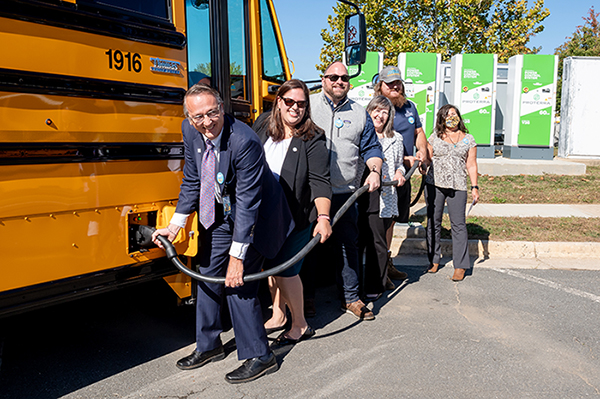When Vicky Hurlebaus, the mother of two elementary-school age children, moved into the Annandale area, her children’s education was at the forefront of her mind and the reputation of FCPS made her decision simple. However, due to the severe overcrowding that has plagued the school for the past several years, Hurlebaus now feels reason to doubt whether AHS is the best fit for her children.
“I’m very concerned about the overcrowding at both the middle school and high school level,” said Hurlebaus. “When we moved here, the schools weren’t overcrowded, so AHS was a really good option. Now, I would really prefer that my kids not go to an overcrowded school – if that school happens not to be AHS, that’s okay. I’m open to any school.”
This sentiment, which is becoming more and more common among parents of younger children, has not gone unnoticed by the Fairfax County School Board. In order to draw more community input and perhaps find some innovative new solutions, a committee made of representatives from various schools has been tasked with undertaking the Annandale Regional Planning Study, or ARPS.
“What it’s vitally important to understand is that this is not a boundary study,” ARPS co-chair and Edgar Allan Poe Middle School representative Jennifer McGarey said. “It’s only a planning study, which means that we’re looking at a whole range of options. The school board might decide to make it a boundary study in the future.”
In order to prevent boundary changes, which could force students to change schools in the middle of their high school years, the committee has been looking at what would happen if certain programs were shifted to or from AHS.
“We took a hard look at the various services at AHS, such as ESOL, Special Ed and IB, and the others that are available, like AP. We tried to see which programs we could move in order to alleviate the overcrowding,” Ramona Morrow, committee representative from Lake Braddock Secondary School, said. “However, we really didn’t feel like we had significant numbers from any given program that would help us with the situation.”
Since changing the programs offered at AHS would be difficult and may not totally alleviate the overcrowding, many feel that a boundary study is on its way, including School Board member Sandra Evans, who represents the Mason District.
“Realistically, the chances are 90 percent or above that a boundary study will be approved by the school board,” Evans said. “If by some miracle the planning study comes up with an idea that would not involve boundary changes, that would be fantastic.”
Although Evans believes that boundary changes are close to inevitable, she still appreciates the work that ARPS has been doing.
“I hope that they can come up with the best solution possible,” Evans said. “The side benefit of this committee is that it has truly involved the members of the community. Although I would love to see more students come to watch the proceeds, after all, they’re the ones who will be most affected by this.”
The ARPS committee will submit their final report to the school board at the end of January. According to Denise James, the Director of Facility Planning Services for FCPS, the Department of Facilities and Transportation, which takes care of many logistical elements needed to run the school system, will then submit a report of its own.
“In our report, we respond to what the [ARPS] committee has said, highlight the ideas that we believe most feasible and make preliminary recommendations as to what should be done,” James said.
Unlike the ARPS committee, which has limited access to specific numbers in order to protect student privacy, the Department of Facilities and Transportation can take a more exact look at how any change will affect students.
“We actually have enrollment projections for the next six years,” James said. “We look at where all of the problems are and the areas a boundary study should target in order to balance enrollment in schools like AHS, Poe Middle School and Frost Middle School.”
Many parents, students and other community members fear that a boundary change might upset the somewhat delicate economic and racial balance within the school.
“One of the requirements pertaining to boundary changes says that any change we make wouldn’t cause a huge swing in demographics at any given school,” Evans said. “We don’t want to have any radical shifts.”
The Department of Facilities and Transportation also takes into account some of the economic factors when making their report.
“We are required by [school] board policy to note the ESOL and Free/Reduced lunch demographic,” said James. “Our goal is to see that these figures do not spike up at any given school.”
For now, however, the study remains in the idea stage, and the committee is open to input.
“Right now we’re focusing on coming up with as many solutions as possible,” McGarey said. “We’re seeing what would happen if we changed programs or created different magnet schools. We’re trying to find ideas that are out-of-the box.”
McGarey also hopes that the committee’s actions will be able to act as a guide for future interaction between the School Board and the community.
“We really want this to serve as a model for any future issues,” McGarey said. “Individual members of the School Board seem really open to looking at the different scenarios we’ve come up with. However, I don’t expect that they’ll take just one scenario, they’ll most likely combine several to come up with a workable solution.”
In order to get more community members involved, McGarey stressed the potential impact any individual could have on the proceedings.
“The community has a tremendous opportunity to help formulate ideas and really make a difference,” McGarey said.
The ARPS committee will hold two more public meetings before the submission of their final report. The meetings, scheduled to take place in AHS’s Lecture Hall, will be held on Dec. 1 and Dec. 15. For more information regarding the Annandale Regional Planning Study, visit http://www.fcps.edu/fts/planning/annandalestudy/index.htm.












